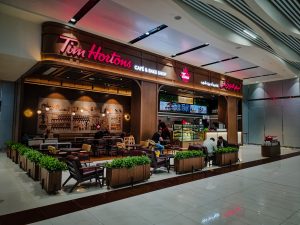6.4 Franchising
Franchising is the practice of using another firm’s successful business model. For the franchiser, the franchise is an alternative to building “chain stores” to distribute goods that avoids the investments and liability of a chain. The franchiser’s success depends on the success of the franchisees. The franchisee is said to have a greater incentive than a direct employee because he or she has a direct stake in the business. Essentially, and in terms of distribution, the franchiser is a supplier who allows an operator, or a franchisee, to use the supplier’s trademark and distribute the supplier’s goods. In return, the operator pays the supplier a fee.
Similar to a licensing agreement, under a franchising agreement, the multinational firm grants rights on its intangible property, like technology or a brand name, to a foreign company for a specified period of time and receives a royalty in return. The difference is that the franchiser provides a bundle of services and products to the franchisee. For example, McDonald’s expands overseas through franchises. Each franchise pays McDonald’s a franchisee fee and a percentage of its sales and is required to purchase certain products from the franchiser. In return, the franchisee gets access to all of McDonald’s products, systems, services, and management expertise.
In short, in terms of distribution, the franchiser is a supplier who allows an operator, or a franchisee, to use the supplier’s trademark and distribute the supplier’s goods. In return, the operator pays the supplier a fee.
Each party to a franchise has several interests to protect. The franchiser is involved in securing protection for the trademark, controlling the business concept, and securing know how. The franchisee is obligated to carry out the services for which the trademark has been made prominent or famous. There is a great deal of standardization required. The place of service has to bear the franchiser’s signs, logos, and trademark in a prominent place. The uniforms worn by the staff of the franchisee have to be of a particular design and colour. The service has to be in accordance with the pattern followed by the franchiser in the successful franchise operations. Thus, franchisees are not in full control of the business, as they would be in retailing.
A service can be successful if equipment and supplies are purchased at a fair price from the franchiser or sources recommended by the franchiser. A coffee brew, for example, can be readily identified by the trademark if its raw materials come from a particular supplier. If the franchiser requires purchase from his stores, it may come under anti-trust legislation or equivalent laws of other countries. So too the purchase of uniforms of personnel, signs, etc., as well as the franchise sites, if they are owned or controlled by the franchiser.
Franchise agreements carry no guarantees or warranties, and the franchisee has little or no recourse to legal intervention in the event of a dispute. Franchise contracts tend to be unilateral contracts in favour of the franchiser, who is generally protected from lawsuits from their franchisees because of the non-negotiable contracts that require franchisees to acknowledge, in effect, that they are buying the franchise knowing that there is risk, and that they have not been promised success or profits by the franchiser. Contracts are renewable at the sole option of the franchiser. Most franchisers require franchisees to sign agreements that mandate where and under what law any dispute would be litigated.
Case: Global Market Entry Modes

Global market entry modes refer to the various strategies that businesses can use to enter international markets (Cateora, Gilly, & Graham, 2021). These include exporting, licensing, joint ventures, franchising, and wholly-owned subsidiaries. Each mode has its own advantages and disadvantages, so businesses need to evaluate various factors before selecting the best expansion mode. For instance, exporting might be a suitable mode for small businesses with limited resources, while joint ventures or wholly-owned subsidiaries might be a better option for larger firms with more capital and expertise.
Tim Hortons is a Canadian company that has successfully used these entry modes (The Canadian Encyclopedia, 2020). The fast-food chain has expanded to several countries, including the United States, Mexico, and the United Arab Emirates, through franchise agreements. Franchising has allowed Tim Hortons to leverage local knowledge and expertise while maintaining its brand standards and control over operations.
Moreover, Tim Hortons has used joint ventures to expand into the Chinese market as it partnered with Cartesian Capital Group, to open over 1,500 stores in China in the next decade (Tim Hortons, 2018). The joint venture model has enabled the company to access local knowledge, overcome regulatory hurdles, and reduce operational costs.
In conclusion, global market entry modes are crucial for businesses seeking to expand their operations beyond their home country. Hence, choosing the right mode requires careful evaluation of various factors, and there is no one-size-fits-all approach.
Diksha Dutta, March 2023
Core Principles of International Marketing – Chapter 7.4 by Babu John Mariadoss is licensed under a Creative Commons Attribution-NonCommercial-ShareAlike 4.0 International License, except where otherwise noted.

